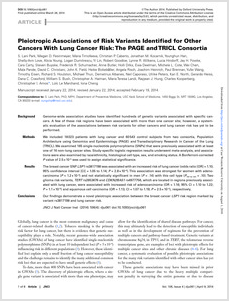Park SL, Fesinmeyer MD, Timofeeva M, Caberto CP, Kocarnik JM, Han Y, Love SA, Young A, Dumitrescu L, Lin Y, Goodloe R, Wilkens LR, Hindorff L, Fowke JH, Carty C, Buyske S, Schumacher FR, Butler A, Dilks H, Deelman E, Cote ML, Chen W, Pande M, Christiani DC, Field JK, Bickebller H, Risch A, Heinrich J, Brennan P, Wang Y, Eisen T, Houlston RS, Thun M, Albanes D, Caporaso N, Peters U, North KE, Heiss G, Crawford DC, Bush WS, Haiman CA, Landi MT, Hung RJ, Kooperberg C, Amos CI, Le Marchand L, Cheng I,.
Genome-wide association studies have identified hundreds of genetic variants associated with specific cancers. A few of these risk regions have been associated with more than one cancer site; however, a systematic evaluation of the associations between risk variants for other cancers and lung cancer risk has yet to be performed.We included 18023 patients with lung cancer and 60543 control subjects from two consortia, Population Architecture using Genomics and Epidemiology (PAGE) and Transdisciplinary Research in Cancer of the Lung (TRICL). We examined 165 single-nucleotide polymorphisms (SNPs) that were previously associated with at least one of 16 non-lung cancer sites. Study-specific logistic regression results underwent meta-analysis, and associations were also examined by race/ethnicity, histological cell type, sex, and smoking status. A Bonferroni-corrected P value of 2.510(-5) was used to assign statistical significance.The breast cancer SNP LSP1 rs3817198 was associated with an increased risk of lung cancer (odds ratio [OR] 1.10; 95% confidence interval [CI] 1.05 to 1.14; P 2.810(-6)). This association was strongest for women with adenocarcinoma (P 1.210(-4)) and not statistically significant in men (P .14) with this cell type (P het by sex .10). Two glioma risk variants, TERT rs2853676 and CDKN2BAS1 rs4977756, which are located in regions previously associated with lung cancer, were associated with increased risk of adenocarcinoma (OR 1.16; 95% CI 1.10 to 1.22; P 1.110(-8)) and squamous cell carcinoma (OR 1.13; CI 1.07 to 1.19; P 2.510(-5)), respectively.Our findings demonstrate a novel pleiotropic association between the breast cancer LSP1 risk region marked by variant rs3817198 and lung cancer risk.

